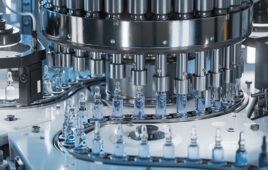
Genentech CSC building exterior, South San Francisco, California [Image courtesy of Genentech]
The planning for the new $250 million center began in 2019 when Genentech, a member of the Roche Group, began earnest efforts to imagine what the future of biomanufacturing looks like.
“We were looking at where we are going in the industry,” said Jeff Davis, the executive director of the Clinical Supply Center (CSC). “And what does Genentech need? What are the trends across the industry?”
One of those trends is prioritizing personalized medicines focused on small patient groups. Genentech thus determined it needed to supplement its large-volume manufacturing with more agile facilities. It began planning the construction of a fast, agile facility that can produce distinct batches on different days and adapt to the changing needs of the pipeline.

Genentech CSC facility ballroom, South San Francisco, California [Image courtesy of Genentech]
“We need to transition from clinical manufacturing to commercial manufacturing very rapidly,” Davis noted. “By having what we are setting up to be a ‘copy-paste’ strategy, we are able to have two facilities.” One of those is clinical, and the other is commercial. The strategy allows the company to use the same layout, equipment, electronic systems, recipes and SOP for clinical and commercial manufacturing. In addition, the approach “dramatically reduces the tech transfer timelines to move a product from clinical manufacturing into commercial manufacturing,” Davis said.
Construction of the facility began in February 2020.
Sustainability emerged as another focus of the clinical supply center, the first Genentech facility to have LEED Gold certification.
The facility also uses 100% renewable energy and is equipped with solar panels.

Genentech CSC facility in operation, South San Francisco, California [Image courtesy of Genentech]
After conducting a lifecycle analysis, the company realized that plastic liners had several benefits. “We are getting away from using a tremendous amount of steam, chemicals and waste that traditionally goes into running a facility,” Davis said. Using plastic liners also reduces the company’s need for HVAC equipment. As a result, the practice condenses the footprint of the facility. “We use less energy. Our overall carbon footprint was lower,” Davis said. “The technology enabled us to be both more efficient and more sustainable at the same time.”
In addition, none of the plastic goes to the landfill. “We have a variety of different streams coming out of the facility,” Davis said. The first option is to reuse materials when possible. Where that is not possible, the company considers whether the plastic can be recycled. “We are looking to set up a circular economy where, for example, clear hard plastics can be recycled into pipette tips that can be reused at Genentech in our research and development groups,” Davis said.
Genentech is also working with supplier partners on plastics that cannot be immediately recycled into a component that the company can immediately use. “Where there is not a viable alternative, we use energy recapture where we are using polymers to generate energy at the local facility,” Davis said. “We are trying to minimize the travel loss of any environmental impact from moving that waste. We are recapturing all the energy and avoiding any of the plastics going into landfills.”
The center’s location in South San Francisco connects with the legacy of Genentech, which was founded in the city in 1976. “Part of that legacy is the connectivity between R&D and manufacturing,” Davis said.
Genentech wanted to build a facility that could efficiently get the molecules developed in its R&D organization through the process development group into manufacturing. “Having that co-location where you can literally just walk across the street and talk to the researcher working on this particular drug is tremendously valuable,” Davis said.
The ability to unite R&D and manufacturing at a single site is at the core of the company’s investment in South San Francisco.
“We have a tremendous amount of knowledge here,” Davis said. “We are leveraging the knowledge both from manufacturing and development to staff this facility and to carry on that legacy that was set up by Genentech when we were first founded at this site.”
Filed Under: Biologics, Cell & gene therapy, clinical trials, Drug Discovery





Tell Us What You Think!
You must be logged in to post a comment.